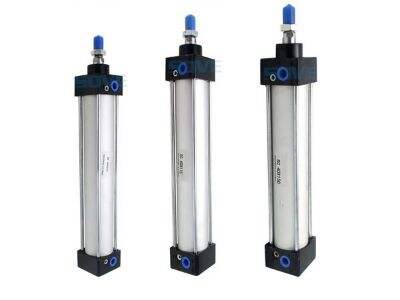Სურათის პროექტისთვის სურვილი გაქვთ? და თუ ასე არის, შეიძლება განიხილავთ სტილური სტილის ვიდრე ალუმინის ცილინდრის არჩევა. თითოეულის მონაწილეობა და უარყოფილობა არის. ეს მახასიათებელები ძვირია გაიგებისა წინა აღწერის შესახებ თქვენი არჩევანი.
Stainless Steel და Aluminum პრიმერი
Რუსტი მეტალი: ეს არის ძალიან დაბინძურებული ტიპი მეტალი, რაც არის მთავარი მიზეზი, რადგან ის შორის არ ქვეყნდება. ამიტომ ეს ხდება იდეალურ პროდუქტი იმ შემთხვევებში, სადაც ცილინდრი იქნება მიწოდებული ჩამონაწილების ან ტეხნური პირობების ქვეშ. რუსტი მეტალი ძალიან მოკლეა, ამიტომ ის შეძლებს დაჭერის და წონის დიდ რაოდენობას გაათიშოს გარკვეული წარმოღების გარეშე ან გამრუდების.
Სხვა一方面, ალუმინი არის მცირე მეტალი. იგი ასევე განიხილებს კოროზიის წინააღმდეგობას, მაგრამ არა იმავე დონეზე, რაც რუსტი მეტალი. ალუმინი არჩევანია პროექტებისთვის, სადაც წონის შემცირება ძალიან მნიშვნელოვანია, რადგან ის მცირეწონია. მაგალითად, ჰაეროსchipში და მანქანის შემოწმებისას, სადაც წონები შეიძლება გამოწვევის ქვეშ ჩამოვალი იქნებინ. ალუმინი არ არის ისეთი ძალიან ძალიან მძლავრი, როგორც რუსტი მეტალი, მაგრამ ის ჯერ არაფერი საშუალებას წარმოადგენს ბევრი სხვადასხვა შემთხვევებისთვის.
Რუსტი მეტალი & ალუმინი ცილინდრების შედარება
Რადგან ჩვენ ველოდებით განვიხილოთ გამოყენების შესახებ Პნევმატიკური ცილინდრი , რომელიც შეიძლება იყოს რკინაული და ალუმინი, ყველაზე გავრცელებული მასალები არის რკინაული და ალუმინი. ანუ, რომელი უნდა აირჩიოთ? პასუხი ნამდვილად დამოკიდებულია თქვენს პროექტის მოთხოვნებზე.
Თუ გჭირდება მასალა, რომელიც არ გადუღებს რის ან გარდაქმნას, მაშინ რკინაული ცილინდრები არის თქვენი პასუხი. მძიმე-მუშაობის ან მძიმე-წყალობის სამუშაოებისთვის ეს ხარისხი მნიშვნელოვანია, რადგან ისინი ასევე უფრო მძიმეა, ვიდრე ალუმინის ცილინდრები. სხვა მხრიდან, ერთი რამ აღინიშნება: რკინაული ცილინდრები ზოგადად მეტ ღირებულია, ვიდრე ალუმინისგან შემორგებული ცილინდრები.
Ან ალუმინის ცილინდრები, თუ წონის ფაქტორი განსაზღვრულია მძიმე და მნიშვნელოვანი ცილინდრების შემოწმებისას. ისინი ხშირად უფრო 埨არია, ვიდრე რკინაული ცილინდრები, რაც ხდის მათ კარგ ალტერნატივას შეზღუდულ პროექტულ ბიუჯეტზე. მიუხედავად ამისა, ალუმინი არ არის ყოველთვის იდეალური მძიმე ან მაღალი წნევის პროექტებისთვის.
Რომელი მასალაა უკეთესი?
Სანამ არჩეული მასალის არჩევა თქვენს პროექტისთვის არ არის ყოველთვის მარტივი. მაგრამ ყველაფერი დაბრუნდება თქვენს საჭიროებაზე. თუ გჭირდებათ ცილინდრი, რომელიც ძალიან წარმოადგენს, მაგრამ მას აქვს მხერობის თვისებები და არ ქვევდება สนელი, შეიძლება გსურთ სტainless სტალი. მაგრამ თუ მთავარად წონის შეკუმშვაზე ხართ დაფიქსირებული, შეიძლება გსურთ ალუმინი.
Სტაილეს სტილის პლუსები და მინუსები Ჰავა პნევმატიკური ცილინდრი
Ასე რომ, აქ არის უფრო ღრმა შეხედვა თითოეული მასალის პლუსებზე და მინუსებზე, რათა მეტი იდეა მიიღოთ.
Სტაილეს სტილის კარგი რეისი:
Მას აქვს მარტივი სნელის და კოროზიის წინააღმდეგობა, რაც მას ძალიან გამარჯვებულობას და გრძელი გამოყენებას აძლევს.
Ეს კომპონენტი ძალიან მხერებული და გამარჯვებულია, რაც გახდის მას მიღებადი გრძელი გამოყენების აპლიკაცია.
Სამუშაო ველში, სადაც გჭირდებათ მანქანა, რომელიც წარმატებულად მატერიალს აწვდის და არ არის არასამართლები.
Ეს ძალიან სასარგებლოა კონკრეტულ სიტუაციებში, რადგან სტაილეს სტილი არ აკარგებს ძალას მაღალი ტემპერატურებში.
Ის ნაკლებად არის შესაძლებელი გამოჩნდეს ან გამოჩნდეს, რადგან ის ძალიან მრავალფეროვანია ალუმინისთვის.
Რასული მეტალი ბოდიშვილი რამე:
Ისინი: ერთ-ერთი უარყოფილი მხარეა იმი, რომ რასული მეტალი ჩანს უფრო ღარიბი, ვიდრე ალუმინი, რაც შეიძლება გახდეს გარკვეული ბიუჯეტებისთვის უარყოფილი.
Თუ თქვენ მუშაობთ პროექტზე, სადაც წონა არის ფაქტორი, განსაზღვრულია მიუთითეთ, რომ ის უფრო მძიმეა, ვიდრე ალუმინი, რაც შეიძლება იყოს სასარგებლო ან უარყოფილი.
Მისი ჭრილადი შეიძლება არ იყოს მარტივი ჭრინდება ან მის გამოყენებით (ზოგჯერ).
Მიუხედავად მისი წონის, ის შეიძლება არ იყოს ნათელი არჩევანი პროექტებისათვის, სადაც წონის მინიმიზაციაა პრიორიტეტი.
Ალუმინის კარგი რამე:
Ყველაზე ცნობილი ალუმინის სასიამართლო იმის გამოა, რომ ის მნიშვნელოვანად მნიშვნელოვანია წონით და მარტივია ავსება და ტრანსპორტირება.
Ის წარმოადგენს წყალწინააღმდეგო წყალს მართლაც, რაც ხელს უწყობს რამდენიმე გამოყენების შემთხვევაში.
Რადგან ალუმინი ბევრად უფრო 埨ადია, ვიდრე რასული მეტალი, ამიტომ ის ისარგებს ხარჯებს ხარჯების შეზღუდვის მიზნით.
Ის არის განსაზღვრული არჩევანი პროექტებისათვის, სადაც წონის მინიმიზაციაა საჭირო, როგორიცაა მანქანებისა და ტექნიკის გამოყენება.
Ალუმინი მარტივია წარმოებისთვის, რაც დროის განმავლობაში დახმარება ხელფასების შენახვაში.
Ალუმინის ცუდი მხარეები:
Მაგრამ მიუხედავად Ქვეყანაში გარეშე მოწყობილობის პნევმატიკული ცილინდრი ძალიან ძალურია, მაგრამ ალუმინი ძალურია მეტ, რაც ხდის მას უფრო შესაბამისს ძალ Gaussian გამოყენებისთვის (რაც ვიმეორებთ, რომ ეს ტელეფონი ჩვენს მოგების მიზნებს შეესაბამების გამო გველოდენილია.)
Არ არის სრულყოფილი მაღალი ტემპერატურების პირი, რაც შეიძლება იყოს უარყოფითი რამდენიმე გარემოში.
Ალუმინი შეიძლება უფრო მრავალჯერ იყოს გამოსახატული ნიშნების ან ჩართვის წინააღმდეგ, რაც ზრდის მას მოსალოდნელი გამოყენების განმავლობაში მიღებული გარემო.
Რომელი მასალა უნდა აირჩიო?
Ალუმინისა და უკვეშავი ნიკელის ცილინდრების შორის არჩევაში, ძალიან მნიშვნელოვანია თქვენი პროექტის მოთხოვნების განსაზღვრა. რამდენიმე კითხვა, რომელიც შეიძლება თავს დააკითხო:
Განხორციელდება ცილინდრი 潮濕 ადგილებში ან მოistinctiveness რისკში?
Განსაზღვრული წყვეტით, დაჭერილი მოხდება თუ მძიმე მოხდების მქონე ტონები?
Არ იყოს თქვენს პროექტში საჭირო მცირე წონის ცილინდრი?
Რამდენი გსურთ გადახდა სხვადასხვა მასალებისთვის, რომლებიც გჭირდებათ?
Უბრალოდ უპასუხეთ ამ კითხვებს და განსაზღვრებთ, რომელი ტიპი ალუმინიუმის ან რუსტოვანი ფეროს ერთეული შეესაბამისია თქვენს საჭიროებებს. თუ გსურთ რუსტოვანობის და გამართლების უნარი, რუსტოვანი ფერო ალბათ პასუხია. თუ მცირე წონი არის თქვენი პირველი და სა Gaussian მნიშვნელოვანი თვისება, ალუმინიუმი შეიძლება გარკვეული გზაა.
Რუსტოვან ფეროსა და ალუმინიუმის არის პლუსები და მინუსები. თქვენს პროექტის სწორი საჭიროების და თითოეული მასალის მერიტებისა და დემერიტების განსაზღვრით, შეგიძლიათ განახლებული, პრაქტიკული გადაწყვეტილება ჩამოთვალოთ. თუ გაქვთ რაიმე დამატებითი კითხვები ან საჭიროა PPC მართვის შესახელმწიფებლად, განათავსეთ ჩვენს გუნდს SOVE-ზე რეკომენდაციებისთვის.


